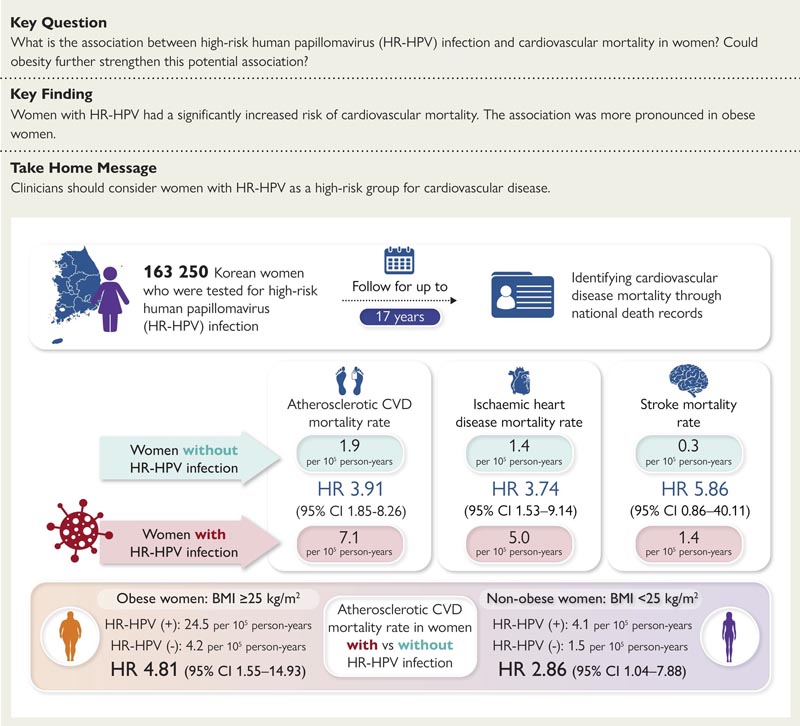Cardiovascular diseases ( CVD) are the leading cause of death worldwide, accounting for approximately 17.9 million deaths (32% of all global deaths) in 2019, and this number is projected to increase to 23.6 million by 2030. Despite considerable advances in management strategies targeting conventional CVD risk factors such as smoking, dyslipidemia, high blood pressure and diabetes, CVD remains a leading cause of death and disability. Furthermore, these conventional risk factors alone do not fully explain the high incidence and prevalence of CVD, as approximately 20% of CVD cases lack these conventional risk factors . Therefore, identifying non-conventional modifiable risk factors for CVD is crucial for developing optimal prevention and treatment strategies to reduce CVD.
Human papillomavirus ( HPV) is a sexually transmitted infection, with a prevalence rate of 2% to 44% in the general female population. High-risk HPV (HR-HPV) infection strains are well-established causative agents of anogenital cancers in women. Several cross-sectional studies have suggested a possible association between HR-HPV and atherosclerotic CVD (ASCVD). Our recent prospective cohort study supports this association in new-onset CVD. However, no cohort studies have evaluated long-term CVD outcomes associated with HR-HPV infection.
Understanding the contribution of HR-HPV infection to long-term cardiovascular consequences in women with HPV may be of important clinical importance, particularly considering the availability of HPV vaccines. Therefore, we conducted a large-scale cohort study of Korean women who underwent HR-HPV testing as part of a health screening program to verify our hypothesis that HR-HPV infection in women It is associated with increased mortality from CVD, with possible effect modification by obesity.
Background and objectives
High-risk human papillomavirus (HR-HPV) infection , a well-established risk factor for cervical cancer, has associations with cardiovascular disease (CVD). However, its relationship with CVD mortality remains uncertain. This study examined associations between HR-HPV infection and CVD mortality.
Methods
As part of a health screening, 163,250 cardiovascular disease-free Korean women (median age: 40.2 years) were screened for HR-HPV and followed for up to 17 years (median: 8.6 years).
National death registries identified cases of CVD mortality. Hazard ratios (HR) and 95% confidence intervals (CI) for CVD mortality were estimated using Cox proportional hazards regression analysis.
Results
During 1,380,953 person-years of follow-up, 134 CVD deaths occurred, with a mortality rate of 9.1 per 10 5 person-years for women with HR-HPV(-) and 14.9 per 10 5 person-years for women with HR-HPV(+) women.
After adjustment for traditional CVD risk factors and confounders, the HRs (95% CI) for atherosclerotic CVD (ASCVD), ischemic heart disease (IHD), and stroke mortality in women with HR-HPV infection compared with those without infection were 3.91 (1.85–8.26), 3.74 (1.53–9.14) and 5.86 (0.86–40.11), respectively.
The association between HR-HPV infection and atherosclerotic CVD (ASCVD) mortality was stronger in women with obesity than in those without obesity (P for interaction = 0.006), with corresponding HRs (95% CI) of 4. 81 (1.55–14.93) for obese women and 2.86 (1.04–7.88) for non-obese women.
Conclusions
In this cohort study of young and middle-aged Korean women, at low risk of CVD mortality, those with HR-HPV infection had higher mortality rates from CVD, specifically atherosclerotic CVD (ASCVD) and ischemic heart disease (IHD). ), with a more pronounced trend in obese individuals.
Graphic summary

High-risk human papillomavirus infection and cardiovascular mortality. HR: risk index; HR-HPV: high-risk human papillomavirus infection; CI: confidence interval; BMI, body mass index; CVD, cardiovascular disease.
Final message In this large cohort study of young and middle-aged Korean women, who have low absolute risks of CVD mortality, we identified a positive association between HR-HPV infection and an elevated risk of CVD mortality, particularly among people with obesity. . Our findings suggest that HR-HPV infection, especially when combined with obesity, may be associated with an increased risk of CVD mortality. Considering the absence of specific antiviral medications targeting HPV and the limited pharmaceutical interventions for HPV-associated inflammation , further research is warranted to explore potential vaccine strategies aimed at reducing HR-HPV infection and the potential use of anti-inflammatory medications in the context of HPV with associated CVD, with the goal of mitigating CVD mortality and improving patient outcomes. |
















